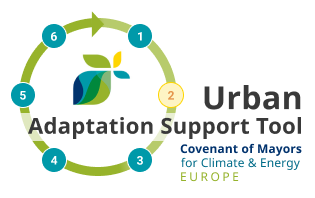
Assessing climate change risks and vulnerabilities
2.5 Understanding the role of surrounding areas in adaptation
Cities cannot be treated in isolation from the regions surrounding them. Settlements depend on both their immediate and further surroundings for various climate-sensitive services and products: agricultural food production, water supply, infrastructure networks, energy production, waste and wastewater management, forestry materials, recreation opportunities and others. Therefore, climate change impacts that might not directly impact the city or town can still have severe repercussions if they hit the area providing these services. Vice versa, climate impacts occurring in the city (e.g. flooding) can affect the surrounding areas if access to urban jobs, resources and various services is disrupted. Thus, the adaptation of a city requires an integrated approach that considers the rural-urban interface and wider surrounding areas. This may require collaboration with neighbouring administrations.
Sustainable adaptation (see "Principles and success factors") avoids transferring risks from one location to another. As cities are closely linked with both their immediate and further surroundings, their wider setting should be considered at various stages of adaptation planning, including:
- Step 2.1: recognition of past impacts (e.g. have previous flooding events affected other areas outside the city? Have the flood management measures used affected areas downstream from the settlement?)
- Step 2.2: understanding future impacts (e.g. if the risk of wildfires is projected to increase, what does it mean for the outwards development of the city or the transport networks?)
- Step 4: assessing and selecting adaptation options (e.g. does securing a steady water supply in the city affect the availability of water for the surrounding agricultural areas?)
- Step 6: monitoring and evaluation (e.g. do the implemented adaptation options bring any disadvantages to the surrounding rural areas?)
Adaptation planning and implementation for an urban area needs to include an analysis of these interlinkages and coordination of adaptation action with the neighbouring municipalities. In some countries the inter-municipality coordination is managed on a national or regional level. Where such arrangements are lacking, it is crucial that cities take initiative to establish a dialogue and win-win approach to urban-rural adaptation. See Step 1.6 for methods to engage stakeholders.
Cities are not only inextricably linked to their immediate surroundings, but their trade and supply chains might extend to other more distant locations within or beyond the borders of the country. The main long-distance dependencies and the arising risks should be accounted for in an urban climate change risk assessment.
